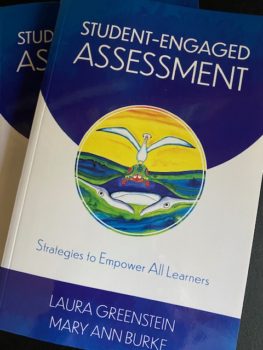What Teachers Can Do to Increase Student Learning
 What Teachers Can Do To Increase Student Learning
What Teachers Can Do To Increase Student Learning
This post is second of a series based on excepts from my book on Student-Engaged Assessment: Strategies to Empower All Learners by Laura Greenstein and Mary Ann Burke (2020). You can purchase the book from Roman and Littlefield for charts, examples, and worksheets on how to engage students to become owners of their learning successes.
Student Ownership of Their Learning
Student ownership of their learning abilities encourages deeper learning. This means exploring learning through multiple lenses to uncover the complex intricacies of learning. For younger children, it is not attending a field trip to a bee farm, but thinking about what would happen if there were no longer bees in the world. Or perhaps, learning about dinosaurs and then creating a dinosaur that could live in today’s environment. Deeper learning helps students recognize that straightforward information often has weightier and broader meanings: And that it can be fun and creative to delve into these ideas.
When students in Ms. Ems’ fifth-grade class were asked to think about a world with no bees, Aman said, “That would be great, because my sister is allergic.” Amira added, “But, I would really miss honey on my peanut butter sandwich.” Ms. Ems explained the importance of bees in pollination and then asked students to imagine a world without whales, or hate, or even teachers.
Student Development of Individualized Learning Intentions
As students become owners of their learning, they begin by identifying the central ideas of a topic, pair these with big-picture standards, develop local learning intentions, and then plan and personalize those aims and goals. In the past, all the students would have watched a video, gone on a field trip, or invited an expert, such as a beekeeper to visit the class to talk about pollination and the production of honey.
Student-Engaged Classrooms
In a student-engaged classroom, students demonstrate their understanding of the broad learning intentions. For example, students can explain the life stages of the honey bee, the construction of their hives, how bees communicate, their role in pollination, and the production and uses of honey. They can then choose a path and strategy for further learning.
Marcella prefers to work solo and wants to create a precise diagram of the inside of a hive. Chester and Deshi want to work together to present the stages of a honey bee’s life. Chara wants to do “something” with honey but isn’t sure yet. She begins by exploring the source, types, nutrients, and uses of honey.
Each student or group then develops and describes their purposes and strategies for learning. They also consider how they can show what they learned and have it assessed in relation to their learning purposes. Each step in the learning process includes specific and intentional learning actions and also how each action and outcome will be assessed. This doesn’t mean there is a quiz after each step. Students monitor progress, adjust their progress, and display evidence with narratives and reflections.
Applying Standards to Student-Owned Learning Intentions
Today’s classrooms are standards-based places. Learning begins with large-scale standards (i.e. reading for information, solving real-world mathematical problems, planning and constructing explanations, and developing solutions). In relation to the honey bee project, those types of large-scale standards are too broad. They need to be customized so that students can understand the purpose and fine-tune their own learning intentions. Here are some examples:
- Reading for information is the foundation for identifying parts of a honeybee or illustrating their life cycle.
- Solving real-world problems can mean planning design specifications for a beehive or a garden that supports pollinators.
- In science, constructing explanations and designing solutions for vanishing bee populations leads to predicting a world without bees and proposing ways to prevent that from happening.
- Social studies standards can be used to explain how a hive is a culture and each type of bee has a specific role.
- Mapping the places in the world where bees are increasing and decreasing can lead to problem-solving.
- Reading materials can be as diverse as the straightforward “Flight of the Honey Bee” by Raymond Huber, “The Case of the Vanishing Bees” by Sandra Markle or for older students, the multilayered “The History of Bees” by Maja Lunde.
Aligning Learning Intentions to Student-Engaged Assessments
From these examples, you can see how student-engaged assessment can be specific to learning intentions and success criteria while being customizable and flexible. It’s not difficult to stretch beyond traditional standards and assessment methods such as quizzes that ask students to define vocabulary or to sequence the life cycle of bees. Higher level thinking such as critical thinking can be self-assessed using a rubric. Self-reflection of problem-solving skills can rely on an annotated checklist of the steps. Alternatively, students can design and create products such as an “Illustrated Guide to Honeybees” that aligns with the content standards and student learning intentions and also includes an assessment for the audience to complete.
Our November 9th post will focus on how teachers can use students to assess learning in the classroom. For more charts, examples, and worksheets on how to engage students to own their learning, you can purchase Student-Engaged Assessment: Strategies to Empower All Learners by Laura Greenstein and Mary Ann Burke (2020) from Roman and Littlefield.